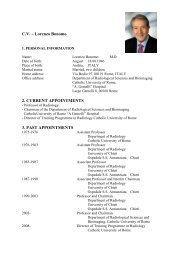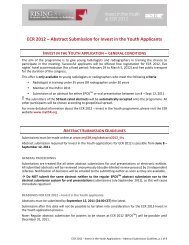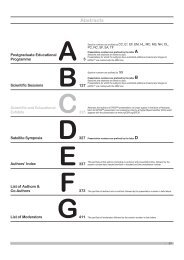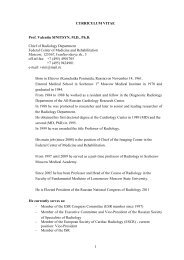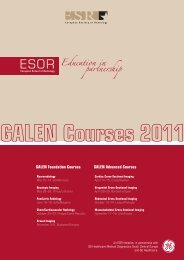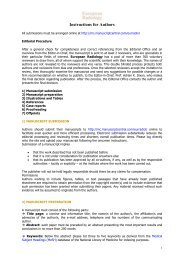Postgraduate Educational Programme - myESR.org
Postgraduate Educational Programme - myESR.org
Postgraduate Educational Programme - myESR.org
- No tags were found...
You also want an ePaper? Increase the reach of your titles
YUMPU automatically turns print PDFs into web optimized ePapers that Google loves.
<strong>Postgraduate</strong> <strong>Educational</strong> <strong>Programme</strong>08:30 - 10:00 Room AAbdominal VisceraRC 401Pitfalls in interpretation of pancreatic imagingModerator:H.‐J. Brambs; Ulm/DEA-055 08:30A. Pancreatic cancer or pancreatitis?B.J. Op de Beeck, A. Snoeckx, M. Spinhoven, R. Salgado, P.M. Parizel;Antwerp/BE (bart.op.de.beeck@uza.be)A common diagnostic problem is how to differentiate malignant solid pancreaticlesions from benign entities like pancreatitis. Especially, if you are dealing withfocal forms like paraduodenal pancreatitis (cystic dystrophy of the duodenumor groove pancreatitis) or autoimmune pancreatitis (IgG4 related pancreatitis).Paraduodenal pancreatitis is a distinct form of chronic pancreatitis characterisedby inflammation and fibrous tissue formation, affecting the groove area nearthe minor papilla between the head of the pancreas, the duodenal wall and thecommon bile duct. Paraduodenal pancreatitis has been divided into pure (thehead of the pancreas is spared), segmental (the pancreatic head and the ductsare affected) and non-segmental (secondary to established chronic pancreatitis)forms. Autoimmune pancreatitis is distinct from calcifying and obstructive formsof chronic pancreatitis. Destructive changes of the pancreatic ducts characterisedby multiple or single strictures without marked upstream dilatation are importantfeatures. Pancreatic calcifications and pseudocysts are usually absent. We radiologistshave the important role to differentiate these benign entities from pancreaticadenocarcinoma, neuroendocrine tumours, lymphoma and pancreatic metastases.The typical CT-findings and limitations will be demonstrated as well as the additionaland complementary role of MRI. We will focus on morphological signs (pancreatic,peripancreatic and ductal), dynamic contrast behaviour and value/limitations ofdiffusion weighted imaging and ADC. Clues to a correct diagnosis will be givenand pitfalls in imaging interpretation will be discussed.Learning Objectives:1. To become familiar with the common benign mimickers of pancreatic malignancy.2. To learn how to differentiate between benign and malignant lesions.3. To know the limitations and complementary roles of CT and MR.A-056 09:00B. How can we differentiate cystic neoplasms from pseudocysts?T. Denecke; Berlin/DE (timm.denecke@charite.de)The differential diagnosis of cystic lesions of the pancreas includes primary neoplasmsand pseudocysts. The clinical relevance of cystic pancreatic lesions is givenbecause cystic neoplasms can be malignant or premalignant. The differentiationof pseudocysts and cystic lesions can be demanding. Ultrasound, endoscopicultrasound, computed tomography and magnetic resonance imaging are the imagingtools employed for differentiation of cystic lesions, supplemented by imageguidedbiopsies. The initial findings determine the sequence of further diagnosticsteps and, if necessary, therapy. The initial non-invasive diagnostic work-up ofincidential cystic lesions usually contents CT and/or MRI. Here, typical patterns ofbenign cystic neoplasms, sings of malignancy, and imaging features in favour ofpseudocyst formations can be recognised. Prerequisites for differential diagnosisby radiologic imaging are a comprehensive examination protocol, exact knowledgeof the entities possibly presenting as cystic lesion including their imaging featuresand clinical relevance, as well as important clinical and paraclinical cofactors whichaid in the discrimination of cystic neoplasms and pseudocysts. These issues willbe demonstrated and discussed in this presentation.Learning Objectives:1. To learn the most common cystic lesions of the pancreas.2. To know typical imaging findings of pseudocysts and cystic tumours.3. To become familiar with imaging elements that help differentiate betweencystic lesions.A-057 09:30C. How to manage incidental findingsC. Triantopoulou; Athens/GR (ctriantopoulou@gmail.com)The diagnosis and management of pancreatic cystic lesions is a common problem.Half of these lesions are asymptomatic and incidentally discovered at the timeS20AB C D E F Gof imaging for other reasons. Although small cysts are more likely to be benign,size alone cannot be an independent decision making variable. Radiologistsmust attempt to exclude the presence of morphologic abnormalities that raise thesuspicion of a complex cyst (mural nodules, dilatation of the common bile duct,dilatation of the main pancreatic duct larger than 6 mm, duct wall enhancement,lymphadenopathy, and peripheral calcifications). Microsyctic adenoma is the onlytype of cystic neoplasm that can be diagnosed with almost complete certainty, whilediagnosis of mucinous cystic tumours is often hypothetical. Determination of CEAand amylase levels in cyst fluid aspirated by EUS-FNA is helpful in making the differentialdiagnosis. Concerning correct management of unclassified cystic lesions atimaging one should keep in mind that even small morphologically benign-appearingcysts present moderate frequency of malignancy. Several professional societieshave developed guidelines for the management of pancreatic cysts. According tothe white paper of the ACR incidental findings committee any cyst > 3 cm shouldbe resected unless it is serous cystadenoma or proven to be pseudocyst throughaspiration. For cysts < 2 cm, a single follow‐up in 1 year is needed, while for thecysts measuring 2-3 cm, a follow‐up of every 6 months for 2 years and then yearlyis proposed. Any decision should be based on a balance between the risk of malignancyand the benefit of pancreatic resection.Learning Objectives:1. To learn how to differentiate between benign and malignant cystic lesions.2. To know the correct management of unclassified cystic lesions through imaging.3. To become familiar with the reference imaging criteria suggesting treatment.08:30 - 10:00 Room COncologic ImagingRC 416MR imaging for prostate cancer management: theessential guide for radiologistsA-058 08:30Chairman’s introductionH.‐P. Schlemmer; Heidelberg/DE (h.schlemmer@dkfz.de)Prostate cancer has become the most frequent cancer in men of the industrialisedcountries over the last 30 years, and the incidence is still increasing. The diseaseis associated with high morbidity and accordingly high socio-economic impact.Although radical prostatectomy has been proven to prolong survival, avoidablemorbidity and costs are feared in a selective but unpredictable patient group dueto overdiagnosis and overtreatment. The conventional way of establishing thediagnosis and making individual treatment decisions relies on the individual PSAserum level and pathologic Gleason score from systematic TRUS biopsy samples,which has well-known limitations. Patient stratification for choosing the best individualtreatment becomes increasingly challenging as various less invasive treatmentalternatives and active surveillance has been established. MultiparametricMR imaging has been proven to be remarkably advantageous in this context fordetecting cancer, characterising its heterogeneity and aggressiveness, targeting themost aggressive part (the dominant intraprostatic lesion, DIL), guiding the biopsyneedle to that area and evaluation of local tumour spreading. The gained informationsupports individualised decision making concerning treatment selection, planning,guidance, monitoring and follow‐up. In case of active surveillance, functional MRparameters additionally yield objective and reproducible biomarkers for monitoringtemporal changes of individual tumour aggressiveness during follow‐up. This coursewill give an insight into the current diagnostic strategies and treatment options inprostate cancer and will discuss the role of MR imaging for patient management.A-059 08:35A. Clinical challenges: how to treat prostate cancerB.A. Hadaschik; Heidelberg/DE (Boris.Hadaschik@med.uni‐heidelberg.de)Prostate cancer (PC) is the third leading cause of male cancer deaths in developedcountries. PSA-based screening results in a modest reduction of PC mortality, butis associated with considerable overdiagnosis of PC, which, in turn, results in asignificant burden of overtreatment. PC diagnosis is currently made by systematicTRUS-guided random biopsies. Indication for biopsy is preferably an individualrisk assessment based on various parameters, predominantly PSA, age, prostatevolume, digital rectal examination, family history, and co-morbidity. However, themajority of biopsies taken are negative. Moreover, random biopsies may missimportant tumours and they also result in cancer detection in men who are unlikelyto benefit from the diagnosis. Precise information of grade, stage and location of




